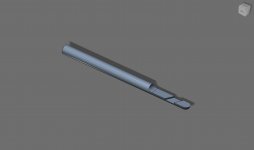This is from "Modern Shop Practice", by Howard Monroe Raymond. 1916.
"Reamers used for finishing a long hole that must be very smooth, are often made of the form shown in Fig. 74. This reamer is drawn through the hole by means of the shank B, the cutting portion being at A. It should cut but a very small amount at each passage through the hole. A piece of hardwood is placed on one side of the reamer, as shown at C. After the reamer has passed once through the hole, a piece of tissue paper is placed between the reamer and the chip, and another cut is taken, this being repeated each time the reamer passes through. Several passages of the reamer and repeated blocking between the chip and reamer, result in a beautifully finished hole of the desired size."
JST have mentioned this a few years ago, but I am wondering if anybody have actually used this process. I need to accurately enlarge (by under 0.1mm, .004") the bore of a heavy wall steel tubes and this could be a good way of doing it. The tubes are about 11mm (0.43") ID and 500mm (20") long. The original bore is quite accurate, as measured with an air gauge.
I'll have no difficulty making a reamer like this in steel or carbide.

"Reamers used for finishing a long hole that must be very smooth, are often made of the form shown in Fig. 74. This reamer is drawn through the hole by means of the shank B, the cutting portion being at A. It should cut but a very small amount at each passage through the hole. A piece of hardwood is placed on one side of the reamer, as shown at C. After the reamer has passed once through the hole, a piece of tissue paper is placed between the reamer and the chip, and another cut is taken, this being repeated each time the reamer passes through. Several passages of the reamer and repeated blocking between the chip and reamer, result in a beautifully finished hole of the desired size."
JST have mentioned this a few years ago, but I am wondering if anybody have actually used this process. I need to accurately enlarge (by under 0.1mm, .004") the bore of a heavy wall steel tubes and this could be a good way of doing it. The tubes are about 11mm (0.43") ID and 500mm (20") long. The original bore is quite accurate, as measured with an air gauge.
I'll have no difficulty making a reamer like this in steel or carbide.





 completely retracting the bit every 1/4" of progress.
completely retracting the bit every 1/4" of progress. 